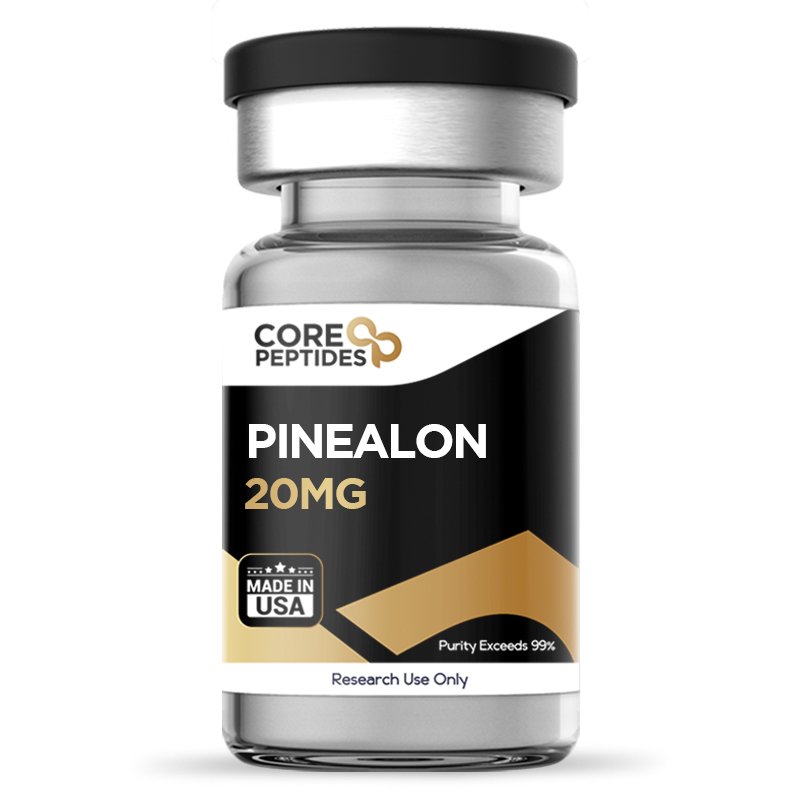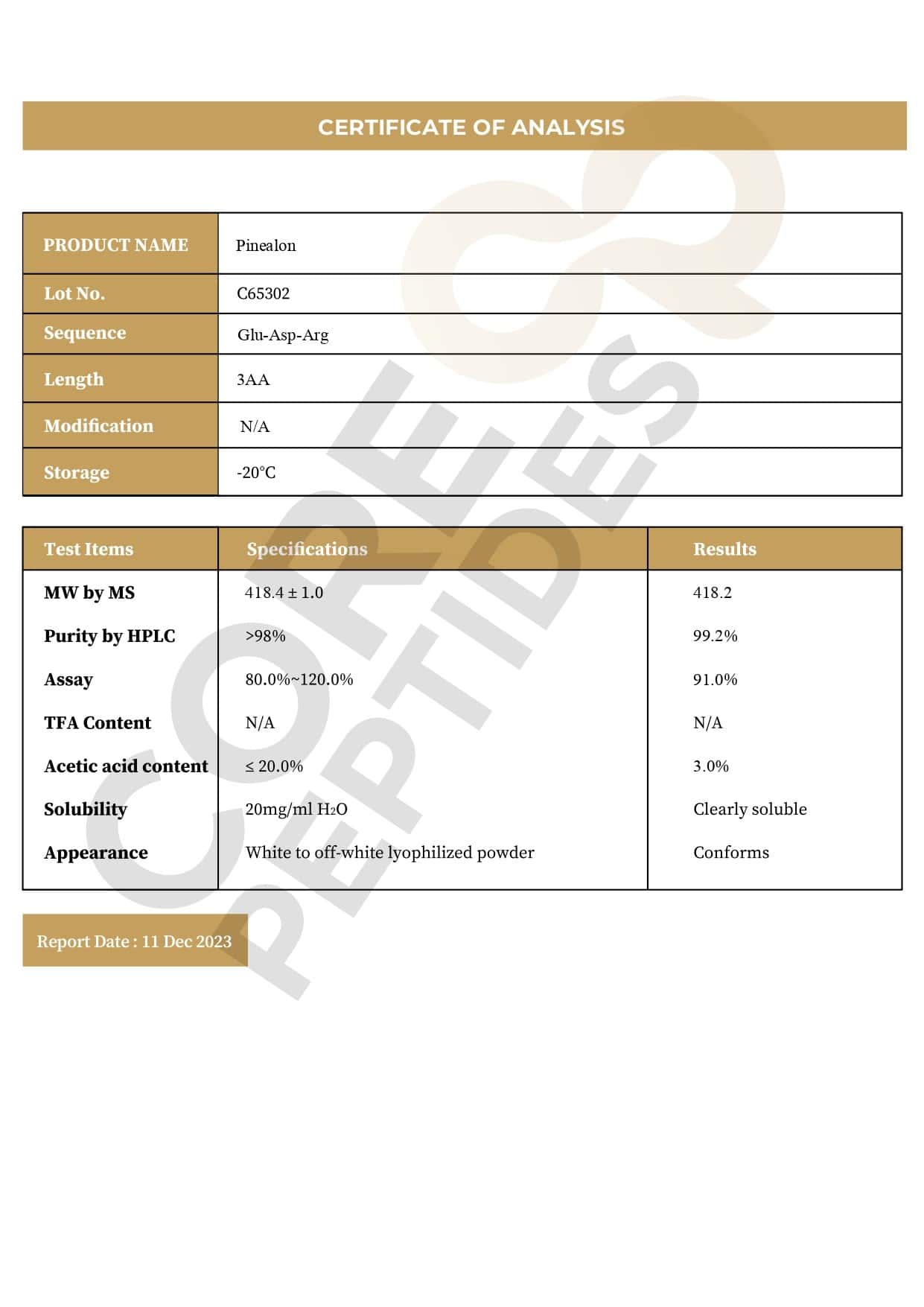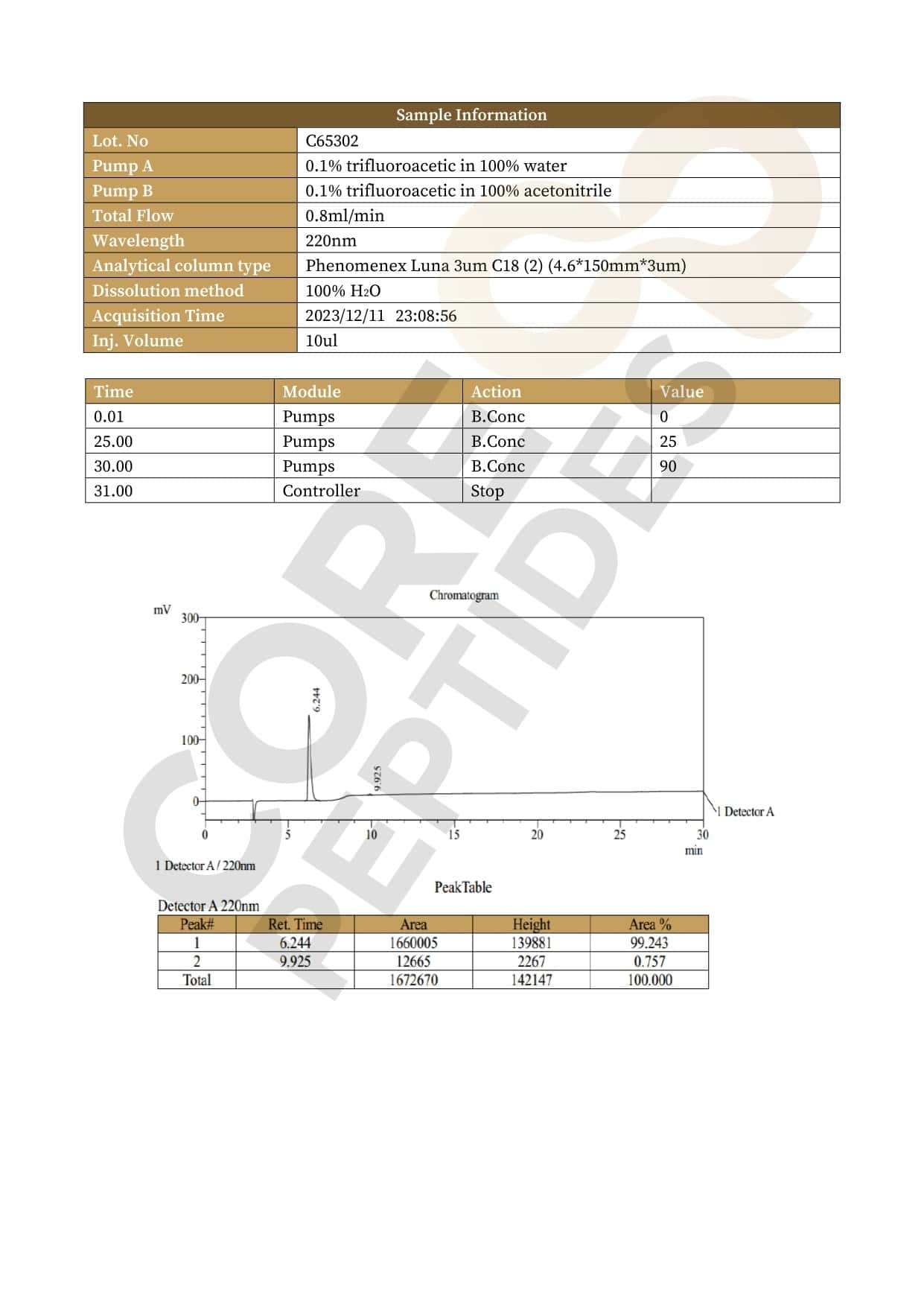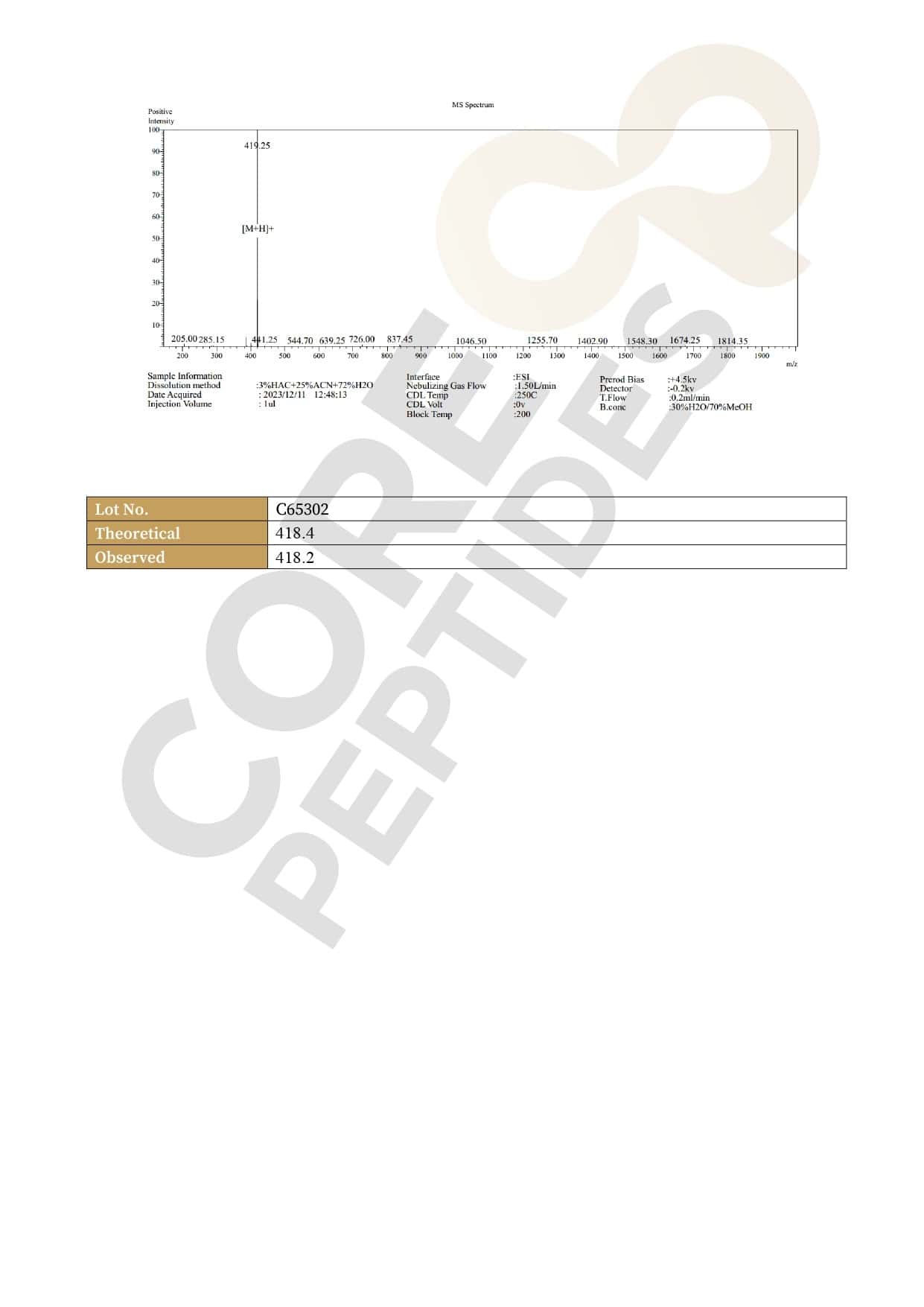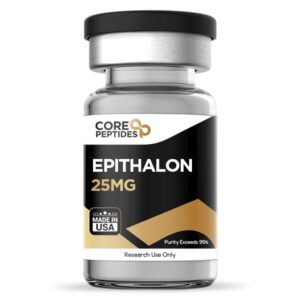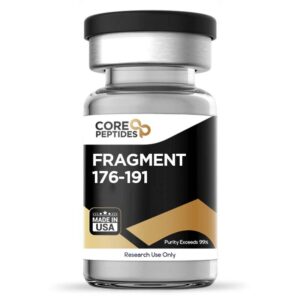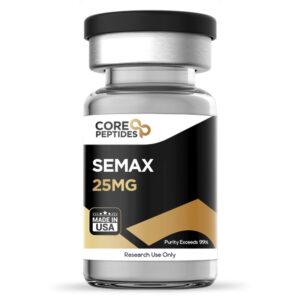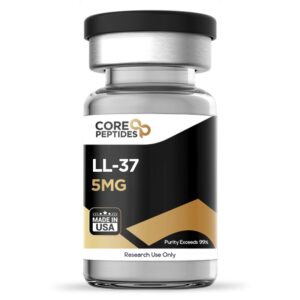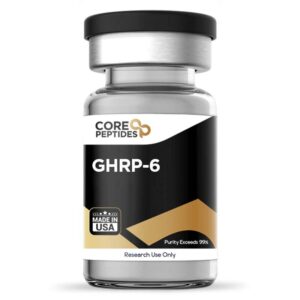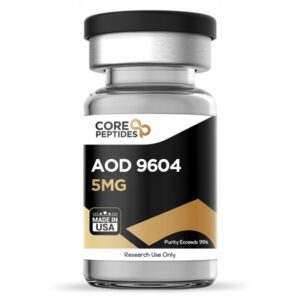Pinealon (20mg)
$71.00
Size: 20mg
Contents: Pinealon (20mg)
Form: Lyophilized powder
Purity: >99%
SKU: P-PINEALON-20
FREE Shipping on $200+ orders
FREE Bacteriostatic Water (30ml) on $200+ orders
Discount per Quantity
| Quantity | Discount | Price |
|---|---|---|
| 5 - 8 | 5% | $67.45 |
| 9 + | 10% | $63.90 |
Pinealon Peptide
Pinealon is a short synthetic peptide composed of three amino acids Glu-Asp-Arg, also known as the EDR peptide.(1)(2) Pinealon is suggested to impact the central nervous system, which may lead to behavior modification while also possibly protecting neurons and various cell types from oxidative stress. The primary research focus on this peptide is evaluating its potential to penetrate the blood-brain barrier, cellular membrane, and nuclear membrane. However, researchers have also suggested that it may also interact directly with DNA molecules.
Pinealon tripeptide is isolated from another chemical compound, Cortexin.(2) Cortexin is a polypeptide with a particularly low molecular weight. Due to this low weigh, Cortexin has been suggested by researchers to cross the blood-brain barrier to produce potential stimulatory action on the neurotransmitters in the brain.(3)
Overview
The neuroprotective and anti-apoptotic potential of the Pinealon peptide has been posited by researchers to be exerted via the MAPK / ERK signaling pathway.(2) The ERK signaling cascade may play a role in the phosphorylation of the substrates, which may lead to elevated neuron plasticity and increased cellular stress. In turn, this action may lead to cellular apoptosis. Similarly, MAPK signaling has been associated with certain metabolic disorders and inflammatory reactions. Researchers suggest that Pinealon may potentially reduce the synthesis of reaction oxygen species (ROS) on the cellular level. ROS is considered a messenger to MAPK and ERK signaling pathways, and the reduced synthesis may lead to a reduction in signaling reactions, preventing cellular stress and cell death.(2)
Studies on Pinealon have suggested a concentration-dependent action. At lower concentrations, the peptide may potentially restrict the synthesis and subsequent accumulation of ROS and cell death. In comparison, the peptide might lead to a modulation of the cell cycle at higher concentrations. Researchers reporting this apparent correlation in peptide presence have suggested that it may exert antioxidant potential at lower concentrations while possibly interacting with the cell genome and altering the cell cycle.(4)
Chemical Makeup
Molecular Formula: C15H26N6O8
Molecular Weight: 418.4 g/mol
Other Known Titles: EDR, Glu-Asp-Arg
Research and Clinical Studies
Pinealon Peptide and Cell Aging
The main purpose of this clinical study was to analyze the cellular and metabolic aspects of synthetic tripeptides, including Pinealon and a similar peptide called Vesugen. As part of this study,(5) research models of poly-morbidity and organic brain syndrome were observed. Both peptides exhibited apparent anabolic potential; researchers reported improvement in the functioning of the central nervous system and other vital organs compared to control models. The peptides did not appear to affect the degree of chromatin condensation, which the researchers indicated may suggest that the peptides do not act on cellular levels.
Another separate study(6) has suggested that the Pinealon peptide may potentially act on muscle cells, modulating the levels of irisin. Scientists consider irisin to be central to muscle cell protection and mainly secreted during physical strain. Irisin may lead to the burning of excessive fat cell stores and is assumed by researchers to induce an elongation of telomeres (DNA caps) as well. By potentially increasing irisin levels, Pinealon may potentially exert protection of DNA telomeres and counteract cell aging action to some degree.
Pinealon Peptide and Prenatal Hyperhomocysteinemia
Scientists characterize hyperhomocysteinemia by the excessive concentration of homocysteine (HC) amino acid in the blood, indicating extreme vitamin deficiency, which might lead to an increased risk of neurological deterioration.(7) The main goal of this study(8) was to determine the potential of Pinealon on experimentally induced hyperhomocysteinemic pregnant female murine models. The female rats were given methionine from their second trimester onwards, which appeared to lead to increased concentration of homocysteine (HC) levels. The rat offspring from the control and the experimental models were then observed for this study. Upon analysis, it was suggested by the researchers that the peptide did not appear to reduce or inhibit the development of homocysteine in the offspring, however, there appeared to be some action seen in the experimental models, as they appeared to exhibit increased cognitive processing. The researchers suggested that the peptide did not appear to induce the metabolism of homocysteine but may have led to reduced toxic action of the compound.
Pinealon Peptide and Serotonin Expression
Studies(9) were conducted on the isolated brain cell cultures where the Pinealon peptide was presented. Upon analysis, it was suggested that the peptide might stimulate levels of serotonin expression in the cell cultures. Preliminary results seemed to indicate that after exposure to Pinealon, there was a notable increase in serotonin synthesis compared to the control groups. This increase was quantitatively assessed to be 1.9 times greater in younger cell cultures. The molecular dynamics behind this observed action might involve Pinealon's interaction with the DNA. It is speculated that this augmentation in serotonin production may be facilitated by Pinealon's potential to bind specifically to a DNA sequence within the promoter region of the gene encoding 5-tryptophan hydroxylase, an enzyme considered to be critical for serotonin synthesis. More specifically, the peptide is hypothesized to bind to a particular nucleotide sequence in the promoter region of the 5-tryptophan hydroxylase gene, potentially enhancing the transcriptional activity of the gene and thus increasing 5-tryptophan hydroxylase enzyme production. Additionally, molecular docking simulations were employed to formulate hypotheses about the peptide’s binding orientation and stability with the DNA. These simulations, which consider factors like hydrophobic interactions, electrostatic forces, and hydrogen bonding, indicated a lower (negative) binding energy for Pinealon compared to another peptide, Lys-Glu-Asp. Such a decrease in binding energy suggests a more stable potential interaction with DNA, which might lead to elevated levels of 5-tryptophan hydroxylase enzyme synthesis and, subsequently, increased serotonin production. Scientists consider serotonin a key mood-stabilizing hormone, and further studies are being conducted to observe the potential of Pinealon on serotonin synthesis.
Another study suggests that Pinealon may potentially influence serotonin levels in the cerebral cortex of murine models under conditions of mild hypothermia. The possible elevation of serotonin levels postulated in the research might indicate that Pinealon could be involved in modulating these aspects of brain function, particularly in response to stress induced by mild hypothermia.(10) The same study also suggests that such models may exert an accumulation of adrenergic mediators when exposed to Pinealon and acute hypobaric hypoxia. Adrenergic mediators are chemicals that transmit nerve impulses and may potentially influence various brain functions, particularly under stress. The increase in these mediators might indicate a response mechanism of Pinealon that may be associated with neuroprotective activities.
Pinealon Peptide and Anti-apoptotic Potential
Studies(11) have suggested that Pinealon peptide may impact the levels of the caspase 3 enzyme. Scientists consider the caspase 3 enzyme an initiator of cell apoptosis (controlled cell death). When Pinealon peptide was presented in experimental murine models of ischemic stroke, the peptide appeared to modulate the levels of this enzyme, thereby shutting down the pathway of cellular death. This, in turn, reportedly reduced hypoxia action during the stroke. The research posits that Pinealon may play a role in reducing neuroinflammation and potentially restoring neurogenic processes to their reference levels, presumably those observed under normoxic (normal oxygen) conditions. By potentially fostering an environment conducive to neurogenesis during hypoxic stress, researchers also posit that Pinealon may contribute to the brain's resilience against oxygen deprivation. In addition to its apparent role in modulating the activity of caspase-3, Pinealon was also suggested to influence levels of interleukin-6 and tumor necrosis factor. Interleukin-6 and tumor necrosis factors are cytokines commonly linked with inflammation and cellular stress responses. The implication is that Pinealon might help bring these inflammatory markers back to baseline levels, thus potentially mitigating the inflammatory response and apoptosis triggered by hypoxic conditions.
The action of suppressing the caspase 3 enzyme was also observed in skin cells. By reducing cellular apoptosis, the peptide may potentially stimulate cell proliferation, possibly leading to an increased regenerative process.(12)
Pinealon peptide is available for research and laboratory purposes only. Please review and adhere to our Terms and Conditions before ordering.
References:
- Khavinson, V., Linkova, N., Kozhevnikova, E., & Trofimova, S. (2020). EDR Peptide: Possible Mechanism of Gene Expression and Protein Synthesis Regulation Involved in the Pathogenesis of Alzheimer's Disease. Molecules (Basel, Switzerland), 26(1), 159. https://www.ncbi.nlm.nih.gov/pmc/articles/PMC7795577/
- National Center for Biotechnology Information. PubChem Compound Summary for CID 10273502, Glu-Asp-Arg. https://pubchem.ncbi.nlm.nih.gov/compound/Glu-Asp-Arg
- Eroğlu, O., Karlıdağ, T., Kuloğlu, T., Keleş, E., Kaygusuz, İ., & Yalçın, Ş. (2018). The Protective Effect of Cortexin on Cisplatin-Induced Ototoxicity. The journal of international advanced otology, 14(1), 27–33. https://www.ncbi.nlm.nih.gov/pmc/articles/PMC6354512/
- Khavinson V, Ribakova Y, Kulebiakin K, Vladychenskaya E, Kozina L, Arutjunyan A, Boldyrev A. Pinealon increases cell viability by suppression of free radical levels and activating proliferative processes. Rejuvenation Res. 2011 Oct;14(5):535-41. https://pubmed.ncbi.nlm.nih.gov/21978084/
- Meshchaninov VN, Tkachenko EL, Zharkov SV, Gavrilov IV, Katyreva Iue. EFFECT OF SYNTHETIC PEPTIDES ON AGING OF PATIENTS WITH CHRONIC POLYMORBIDITY AND ORGANIC BRAIN SYNDROME OF THE CENTRAL NERVOUS SYSTEM IN REMISSION. Adv Gerontol. 2015;28(1):62-7. Russian. PMID: 26390612. https://pubmed.ncbi.nlm.nih.gov/26390612/
- Khavinson VKh, Kuznik BI, Tarnovskaya SI, Lin'kova NS. Short Peptides and Telomere Length Regulator Hormone Irisin. Bull Exp Biol Med. 2016 Jan;160(3):347-9. doi: 10.1007/s10517-016-3167-y. Epub 2016 Jan 8. PMID: 26742748. https://pubmed.ncbi.nlm.nih.gov/26742748/
- Homocysteine. https://my.clevelandclinic.org/health/articles/21527-homocysteine
- Arutjunyan, A., Kozina, L., Stvolinskiy, S., Bulygina, Y., Mashkina, A., & Khavinson, V. (2012). Pinealon protects the rat offspring from prenatal hyperhomocysteinemia. International journal of clinical and experimental medicine, 5(2), 179–185. https://www.ncbi.nlm.nih.gov/pmc/articles/PMC3342713/
- Khavinson, V.K., Lin’kova, N.S., Tarnovskaya, S.I. et al. Short Peptides Stimulate Serotonin Expression in Cells of Brain Cortex. Bull Exp Biol Med 157, 77–80 (2014). https://link.springer.com/article/10.1007/s10517-014-2496-y#citeas
- Mendzheritsky AM, Karantysh GV, Ryzhak GA, Prokofiev VN. [Pinealon and Cortexin influence on behavior and neurochemical processes in 18-month aged rats within hypoxia and hypothermia]. Adv Gerontol. 2015;28(3):532-539. Russian. PMID: 28509493.
- Mendzheritskiĭ AM, Karantysh GV, Ryzhak GA, Dem'ianenko SV. [Regulation of content of cytokines in blood serum and of caspase-3 activity in brains of old rats in model of sharp hypoxic hypoxia with Cortexin and Pinealon]. Adv Gerontol. 2014;27(1):94-7. Russian. PMID: 25051764. https://pubmed.ncbi.nlm.nih.gov/25051764/
- Voicekhovskaya MA, Chalisova NI, Kontsevaya EA, Ryzhak GA. Effect of bioregulatory tripeptides on the culture of skin cells from young and old rats. Bull Exp Biol Med. 2012 Jan;152(3):357-9. doi: 10.1007/s10517-012-1527-9. PMID: 22803085. https://pubmed.ncbi.nlm.nih.gov/22803085/

